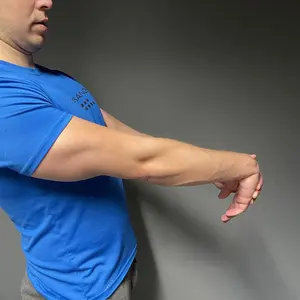Extensor Carpi Radialis Stretch: How to Do it Right Way
In this post, I will show you how to properly stretch the extensor carpi radialis muscle.
The extensor carpi radialis muscle is one of the five major muscles that control movements at the wrist joint.
The extensor carpi radialis stretch is a wrist joint movement that serves to relax and reduce tension in the muscles of the forearm and elbow that extend the wrist and fingers.
It is performed by bending the wrist downward while the elbow joint is extended.
Standing Extensor Carpi Radialis Stretch
- Extend one arm at the elbow joint
- Grasp your hand with the other hand and gently press the hand downward
- Hold for 30s
Quadruped Extensor Carpi Radialis Stretch
Assume a quadruped position with the upper part of your hand resting on the floor and your fingers pointing towards you. Gently lean forward, increasing the pressure on the stretch of the extensor carpi radialis muscles. When you find the appropriate stretching pressure, hold for 30 seconds.
Wall Stretch for Extensor Carpi Radialis Muscle
Stand parallel to a wall and place the upper part of your hand against the wall at shoulder height. Then, slightly bend your knees to increase the stretch in the carpi radialis muscle. When you reach the appropriate intensity of the stretch, hold that position for 30 seconds.
When to Stretch Extensor Carpi Radialis Muscle
I recommend doing these stretching exercises after activities that require the engagement of the extensor carpi radialis muscle.
This could be after a gym workout, playing tennis, or a strenuous day at work that requires strong hand physical strength.
Tendonitis
Extensor carpi radialis is often prone to injury in sports like tennis or rowing.
It is highly active during computer work, increasing the chances of tendon inflammation, especially in individuals who work on computers.
Constant strain on this muscle easily leads to tendonitis. Tendonitis of this muscle is also known as lateral epicondylitis or tennis elbow.
In this condition, there is usually a dull pain in the elbow area that radiates towards the fingers, as well as weakness in the hands when gripping.
Stretching this muscle is an excellent way to reduce these discomforts and prevent this painful condition.
In addition to stretching exercises, strengthening exercises involving wrist and finger extension are also recommended.

